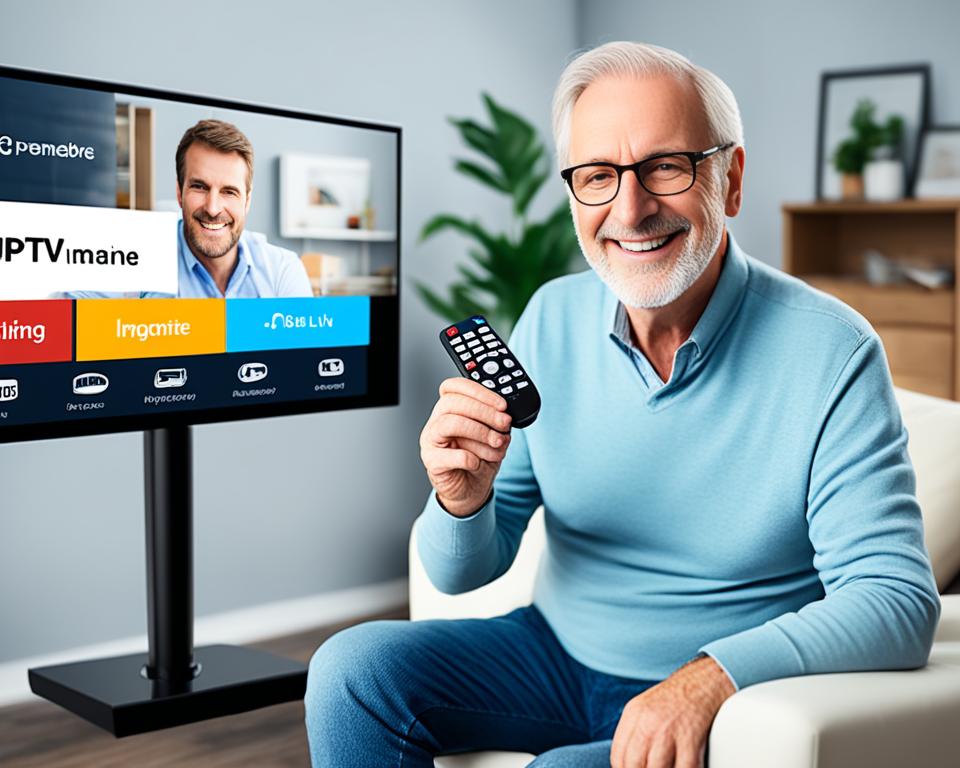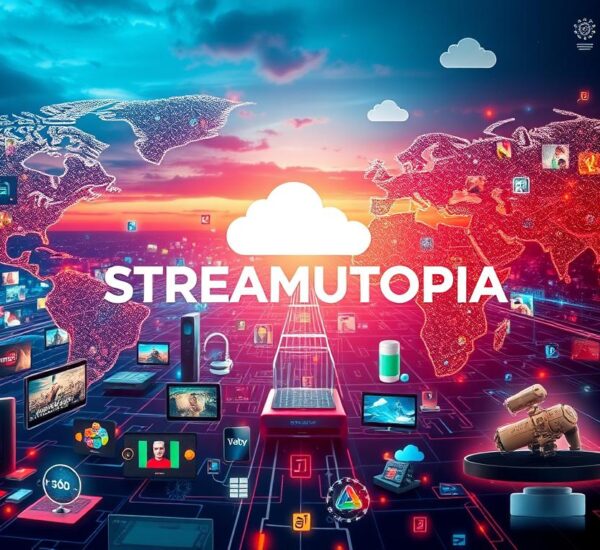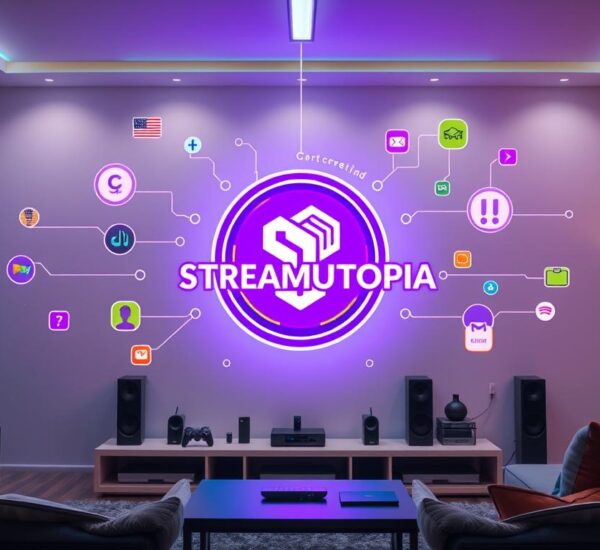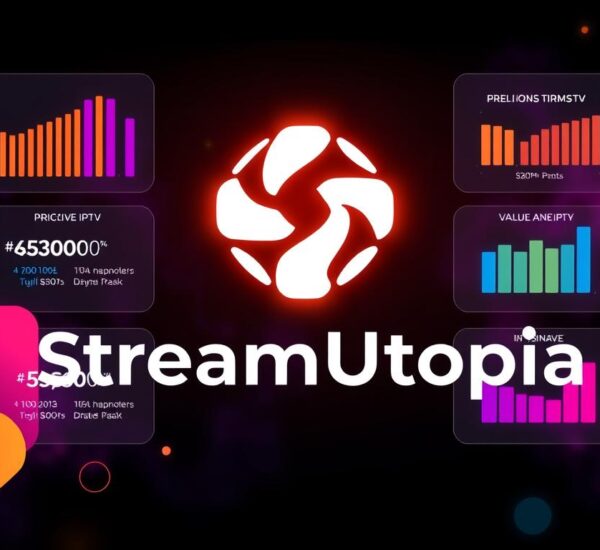Did you know that over 1 billion people, or approximately 15% of the world’s population, live with some form of disability? For these individuals, accessing and enjoying television programs can be a challenging task. However, with the advent of IPTV (Internet Protocol Television), the television experience has become more inclusive and accessible. IPTV platforms now offer a range of accessibility features, including adaptive streaming, audio description, and closed captioning, catering to the needs of differently-abled viewers.
Key Takeaways
- IPTV platforms provide accessibility features to cater to differently-abled viewers.
- Adaptive streaming in IPTV ensures a smooth playback experience for visually impaired viewers.
- Audio description enhances the viewing experience for visually impaired individuals.
- Closed captioning enables individuals with hearing impairments to understand television content.
- IPTV accessibility tools empower differently-abled viewers to personalize their viewing experience.
The Importance of IPTV Accessibility for Differently-Abled Viewers
Accessible television is crucial for fostering inclusive societies and providing equal opportunities for individuals with disabilities. IPTV (Internet Protocol Television) accessibility features play a pivotal role in ensuring an inclusive viewing experience for differently-abled viewers. These features enable individuals with various disabilities to access and enjoy television content on an equal footing with others.
One of the key IPTV accessibility features is adaptive streaming. This technology automatically adjusts the quality of the video stream based on the viewer’s internet connection and device capabilities. Adaptive streaming not only ensures a smoother playback experience for all viewers but also provides specific benefits for differently-abled individuals.
Differently-abled viewers with visual impairments can benefit from IPTV’s audio description feature. Audio description provides additional narration that describes visual elements, allowing visually impaired individuals to fully comprehend and engage with the content. Through audio description, IPTV makes television more accessible and provides a more immersive viewing experience for the visually impaired.
Another important IPTV accessibility feature is closed captioning. Closed captions display text on the screen, providing a transcript of the dialogue and other important audio elements. This feature benefits individuals with hearing impairments or language barriers, allowing them to understand and enjoy the content. Closed captioning also plays a crucial role in ensuring accessibility compliance across different regions.
Furthermore, assistive technology plays a vital role in IPTV accessibility. Differently-abled viewers with mobility issues can control their TV viewing experience using assistive technology devices, enhancing their independence and convenience.
Benefits of IPTV Accessibility Features for Differently-Abled Viewers:
- Enhanced accessibility for individuals with visual impairments through audio description.
- Improved comprehension and enjoyment for individuals with hearing impairments through closed captioning.
- Greater independence and convenience for individuals with mobility issues through assistive technology compatibility.
- Promotion of an inclusive viewing experience, ensuring that everyone has equal access to television content.
By incorporating these accessibility features, IPTV platforms create a more inclusive viewing experience, enriching the lives of differently-abled viewers and promoting accessibility across the television industry.
| Accessibility Feature | Description |
|---|---|
| Adaptive Streaming | Automatically adjusts video quality based on internet connection and device capabilities. |
| Audio Description | Provides additional narration to describe visual elements for the visually impaired. |
| Closed Captioning | Displays text of dialogue and other audio elements for individuals with hearing impairments or language barriers. |
| Assistive Technology Compatibility | Allows individuals with mobility issues to control their TV viewing experience through assistive devices. |
IPTV accessibility features, such as adaptive streaming, audio description, closed captioning, and assistive technology compatibility, play a pivotal role in ensuring an inclusive viewing experience for differently-abled viewers. These features empower individuals with disabilities, providing them with equal opportunities to access and enjoy television content. By prioritizing IPTV accessibility, the television industry takes a significant step towards inclusivity and accessibility for all viewers.
The Benefits of Adaptive Streaming in IPTV for Differently-Abled Viewers
Adaptive streaming is a significant technological advancement in IPTV that offers numerous benefits for differently-abled viewers. This feature automatically adjusts the quality of the video stream based on the viewer’s internet connection and device capabilities, ensuring a seamless playback experience. For visually impaired viewers, adaptive streaming provides enhanced accessibility options, empowering them to enjoy IPTV content effortlessly.
Smooth Playback Experience
Adaptive streaming enables a smooth and uninterrupted playback experience for differently-abled viewers. By dynamically adjusting the video quality in real-time, the technology ensures that the streaming remains stable, even with varying internet connection speeds. This benefit is especially crucial for visually impaired individuals who heavily rely on audio descriptions and other accessibility features to comprehend the content.
Audio Description Adjustment
IPTV platforms offering adaptive streaming often provide options for adjusting audio descriptions, catering to the needs of visually impaired viewers. This feature allows users to customize the volume and clarity of the audio descriptions according to their preferences. By fine-tuning the audio descriptions, differently-abled viewers can optimize their viewing experience and enjoy content that is tailored to their specific accessibility requirements.
Visually Impaired-Friendly Interfaces
Adaptive streaming in IPTV also supports visually impaired-friendly interfaces, further enhancing the accessibility for visually impaired individuals. These interfaces include features such as high contrast colors, larger fonts, and simplified navigation, making it easier for visually impaired viewers to navigate through the IPTV platform and access their desired content. The visually impaired-friendly interfaces ensure a seamless and user-friendly experience for differently-abled viewers.
Improved User Control
Adaptive streaming empowers differently-abled viewers to have greater control over their IPTV experience. With customizable accessibility settings, users can personalize their preferences based on their specific needs. This includes adjusting subtitles, closed captions, audio track preferences, and other accessibility features. The improved user control offered by adaptive streaming enables differently-abled individuals to create a personalized and inclusive IPTV experience.
| Benefits of Adaptive Streaming in IPTV for Differently-Abled Viewers |
|---|
| Smooth and uninterrupted playback experience |
| Customizable audio descriptions for enhanced accessibility |
| Visually impaired-friendly interfaces |
| Improved user control over accessibility settings |
Enhancing Accessibility with Audio Description for IPTV
Audio description plays a critical role in enhancing accessibility for visually impaired viewers in IPTV. This important feature provides additional audio narration that describes essential visual elements, such as actions, expressions, and settings, during television programs. By offering audio description tracks for select programs, IPTV platforms prioritize inclusivity and provide a more immersive and enjoyable viewing experience for visually impaired individuals.
With audio description, visually impaired viewers can fully comprehend and engage with the content through audio cues. This feature enables them to follow the storyline, understand character interactions, and visualize the scene even without relying on visual cues. By hearing descriptive narration alongside the audio of the program, individuals with visual impairments gain a more comprehensive understanding of the program’s visual details.
IPTV platforms integrate audio description as an accessibility option to ensure that visually impaired individuals can fully enjoy a wide range of television content, including movies, TV shows, documentaries, and more. The availability of audio description tracks further promotes inclusivity and equal access to entertainment and information for all viewers.

| Potential Benefits of Audio Description for IPTV |
|---|
| Enhanced accessibility for visually impaired individuals |
| Improved comprehension of visual elements in television programs |
| Equal access to a wide range of television content |
| Increased immersion and enjoyment while watching TV programs |
| Promotion of inclusivity and equal access to entertainment |
Closed Captioning: An Essential Accessibility Feature for IPTV
Closed captioning is a vital accessibility feature that ensures television content is accessible to differently-abled viewers, including those with hearing impairments or language barriers. IPTV platforms offer closed captioning options that display a text overlay of the dialogue and other important audio elements during television programs. This feature enables individuals with hearing impairments to fully understand the content and enjoy an inclusive viewing experience.
Accessibility settings in IPTV platforms allow users to customize their closed captioning preferences, tailoring the experience to suit their needs. Users can adjust the font size, choose background colors that enhance readability, and even enable additional features like speaker identification or sound effect descriptions. These customization options empower differently-abled viewers to have a personalized and enjoyable television experience.
Benefits of Closed Captioning in IPTV
Closed captioning in IPTV provides several benefits for differently-abled viewers:
- Improved comprehension: Closed captioning enables individuals with hearing impairments to understand the dialogue, sound effects, and other audio elements of a television program. This feature ensures that no important information is missed, fostering a more complete viewing experience.
- Language accessibility: Closed captioning also benefits viewers who have language barriers. By displaying text in their native language, individuals who are not fluent in the program’s spoken language can fully engage with the content.
- Enhanced learning: Closed captioning can be particularly beneficial for educational programs or documentaries. It helps viewers follow along with complex subject matter, reinforcing comprehension and knowledge retention.
By providing closed captioning as an accessibility feature, IPTV platforms contribute to a more inclusive and equitable television experience for all viewers. This feature ensures that differently-abled individuals can access information, entertainment, and cultural content without any limitations.
| Benefits | Description |
|---|---|
| Improved comprehension | Enables individuals with hearing impairments to understand dialogue, sound effects, and other audio elements. |
| Language accessibility | Allows viewers with language barriers to engage with content in their native language. |
| Enhanced learning | Fosters increased comprehension and knowledge retention, particularly for educational programs and documentaries. |
The table highlights the benefits of closed captioning in IPTV for differently-abled viewers.
IPTV Accessibility Tools and Options for Differently-Abled Viewers
IPTV platforms recognize the importance of catering to the diverse needs of differently-abled viewers. To ensure an inclusive viewing experience, these platforms offer a wide range of accessibility tools and options. By leveraging these features, individuals with disabilities can customize their IPTV experience according to their specific requirements and preferences.
Customizable Closed Captioning Settings
One of the key accessibility tools available on IPTV platforms is customizable closed captioning settings. Closed captioning provides a text overlay of the dialogue and audio elements during television programs, enabling individuals with hearing impairments or language barriers to understand the content fully. IPTV platforms allow users to customize their closed captioning preferences, including font size, color, and background, to suit their specific needs.
Adjustable Audio Description Tracks
Another essential feature for differently-abled viewers is adjustable audio description tracks. Audio description involves providing additional narration that describes important visual elements during television programs. IPTV platforms offer adjustable audio description tracks, enabling individuals with visual impairments to access comprehensive audio descriptions that enhance their understanding and enjoyment of the content.
Assistive Technology Compatibility
IPTV platforms are designed to be compatible with various assistive technologies, further enhancing accessibility for differently-abled viewers. These technologies include screen readers, voice recognition systems, and other assistive devices that enable individuals with disabilities to control their IPTV experience more effectively. By integrating with assistive technologies, IPTV platforms ensure that individuals with different abilities can navigate the interface and access content seamlessly.
To summarize, IPTV platforms provide a range of accessibility tools and options to accommodate the needs of differently-abled viewers. Customizable closed captioning settings, adjustable audio description tracks, and assistive technology compatibility empower individuals with disabilities to personalize their IPTV experience. By offering these accessibility features, IPTV platforms strive to create a more inclusive and enjoyable viewing experience for all users.
The Role of Regulations and Guidelines in IPTV Accessibility
The importance of IPTV accessibility for differently-abled viewers is recognized globally, leading to the establishment of regulations and guidelines. These regulations outline the requirements and standards that IPTV providers must adhere to in terms of accessibility features. Additionally, guidelines are developed to assist IPTV providers in implementing inclusive design principles and ensuring optimal accessibility for all users. By complying with these regulations and guidelines, IPTV platforms can enhance the accessibility of their services and cater to the needs of differently-abled viewers.
Advancements in IPTV Accessibility Technologies and Innovations
The field of IPTV accessibility has seen remarkable progress with the constant advancements in technology and the introduction of innovative features. These advancements have revolutionized the way differently-abled viewers access and enjoy television content. IPTV platforms are dedicated to continuously improving their services, making them more accessible and user-friendly.
Improved Speech Recognition for Closed Captioning
One of the key advancements in IPTV accessibility is the improved speech recognition technology used for closed captioning. With this innovation, IPTV platforms can accurately transcribe and display text in real-time, ensuring that individuals with hearing impairments or language barriers can follow the dialogue effortlessly. This technology enhances the inclusivity of television programs, making them accessible to a wider range of viewers.
Enhanced Audio Description Techniques
Another significant advancement in IPTV accessibility is the development of enhanced audio description techniques. Audio descriptions provide additional narration to describe visual elements that are crucial for understanding television programs. With advancements in this technology, IPTV platforms can deliver more immersive and accurate audio descriptions, enabling visually impaired viewers to comprehend and enjoy the content better.
Integration of Assistive Technologies
Integrating assistive technologies is a key focus for IPTV platforms, enabling them to provide a more inclusive viewing experience. These technologies include compatibility with screen readers, voice controls, and other assistive devices. By integrating these tools, IPTV platforms can empower differently-abled viewers with disabilities such as visual impairments or limited mobility, allowing them to navigate and control their IPTV experience with ease.
Through these advancements and continued innovation, IPTV accessibility has undergone a transformative journey. Differently-abled viewers can now access an array of innovative features, including improved speech recognition for closed captioning, enhanced audio descriptions, and the integration of assistive technologies. These advancements have paved the way for a more inclusive and enjoyable television experience for all users, regardless of their abilities or disabilities.

Caption: Advancements in IPTV accessibility have made television content more accessible to differently-abled viewers.
The Impact of IPTV Accessibility on the Television Industry
The rapid advancement of IPTV accessibility has revolutionized the television industry, profoundly impacting how content is consumed and experienced. By incorporating accessibility features, IPTV platforms have not only expanded their audience reach but also provided an inclusive television viewing experience for differently-abled viewers.
Through the integration of closed captioning, audio description, and adaptive streaming technologies, IPTV platforms have created a more welcoming and accessible environment for individuals with disabilities. These features ensure that everyone, regardless of their abilities, can fully engage with and enjoy television programs.
Moreover, the increased focus on IPTV accessibility has fueled a demand for more diverse and inclusive content. Content creators and broadcasters are now prioritizing the inclusion of accessibility features in their programming, recognizing the importance of catering to the needs of differently-abled viewers. This shift towards inclusivity not only enhances the viewing experience for individuals with disabilities but also promotes a more equitable and inclusive media landscape.
As the television industry continues to evolve, IPTV accessibility remains a significant driving force behind the commitment to providing equal access to all viewers. By incorporating inclusive features and embracing the principles of universal design, IPTV platforms play a critical role in shaping the future of accessible entertainment and information.
Advantages of IPTV Accessibility on the Television Industry:
- Expanded audience reach through inclusive television viewing experiences
- Elevated demand for diverse and inclusive content
- Prioritization of accessibility features by content creators and broadcasters
- Fostering a more equitable and inclusive media landscape
The Future of IPTV Accessibility for Differently-Abled Viewers
The future of IPTV accessibility for differently-abled viewers holds immense potential, thanks to continuous advancements in accessibility technology. As technology evolves, IPTV platforms are expected to integrate even more sophisticated features, revolutionizing the viewing experience for individuals with disabilities. Some of the exciting advancements in accessibility technology that we can anticipate include:
- Real-time translation services: Breaking down language barriers, real-time translation services will enable differently-abled viewers to enjoy television content in their preferred language. This feature will provide a more inclusive and immersive experience, promoting accessibility on a global scale.
- Gesture-based controls: Integrating gesture recognition technology, IPTV platforms will offer an alternative method of control for individuals with mobility impairments. Users will be able to navigate through menus, change channels, and control playback using natural hand movements, making television viewing more accessible and interactive.
- Personalized content recommendations: By leveraging artificial intelligence and machine learning algorithms, IPTV platforms will be able to offer personalized content recommendations based on specific accessibility needs. This tailored approach will enhance the user experience by presenting content that aligns with individual preferences and accessibility requirements.
With these advancements in accessibility technology, the future of IPTV accessibility holds exciting prospects for differently-abled viewers. The continued dedication to inclusivity and the implementation of innovative features will ensure that television content becomes more accessible than ever before, opening up new possibilities for accessible entertainment and information.
| Advancements in Accessibility Technology | Benefits for Differently-Abled Viewers |
|---|---|
| Real-time translation services | Breaking language barriers and enabling global accessibility |
| Gesture-based controls | Providing alternative control options for individuals with mobility impairments |
| Personalized content recommendations | Offering tailored content suggestions based on specific accessibility needs |
Conclusion
IPTV accessibility features and technologies have revolutionized the television viewing experience for differently-abled viewers. With adaptive streaming, audio description, closed captioning, and various accessibility tools, IPTV platforms are empowering individuals with disabilities to access and enjoy television content like never before.
Adaptive streaming ensures a seamless playback experience for disabled viewers, allowing them to adjust audio descriptions and explore visually impaired-friendly interfaces. The inclusion of audio description provides a more immersive and inclusive experience for visually impaired individuals, while closed captioning enables individuals with hearing impairments or language barriers to fully understand the content.
The availability of IPTV accessibility tools and settings facilitates a personalized experience, allowing individuals to customize closed captioning, font size, and audio preferences. These advancements in IPTV accessibility have brought about a more inclusive and equal viewing experience, ensuring that individuals with disabilities can fully participate in the world of entertainment and information.
The future of IPTV accessibility holds even more exciting possibilities as technology continues to evolve. We can anticipate advancements such as real-time translation services, gesture-based controls, and personalized content recommendations based on specific accessibility needs. These innovations will further enhance the inclusive viewing experience for differently-abled individuals, opening up new possibilities for accessible entertainment and information.
FAQ
What is adaptive streaming in IPTV?
How does adaptive streaming benefit differently-abled viewers?
What is audio description in IPTV?
How does audio description enhance the viewing experience for visually impaired individuals?
What is closed captioning in IPTV?
How does closed captioning make television content accessible to differently-abled viewers?
What accessibility tools and options are available for differently-abled viewers in IPTV platforms?
Are there regulations and guidelines for IPTV accessibility?
How is technology advancing IPTV accessibility?
How has IPTV accessibility impacted the television industry?
What does the future hold for IPTV accessibility?





